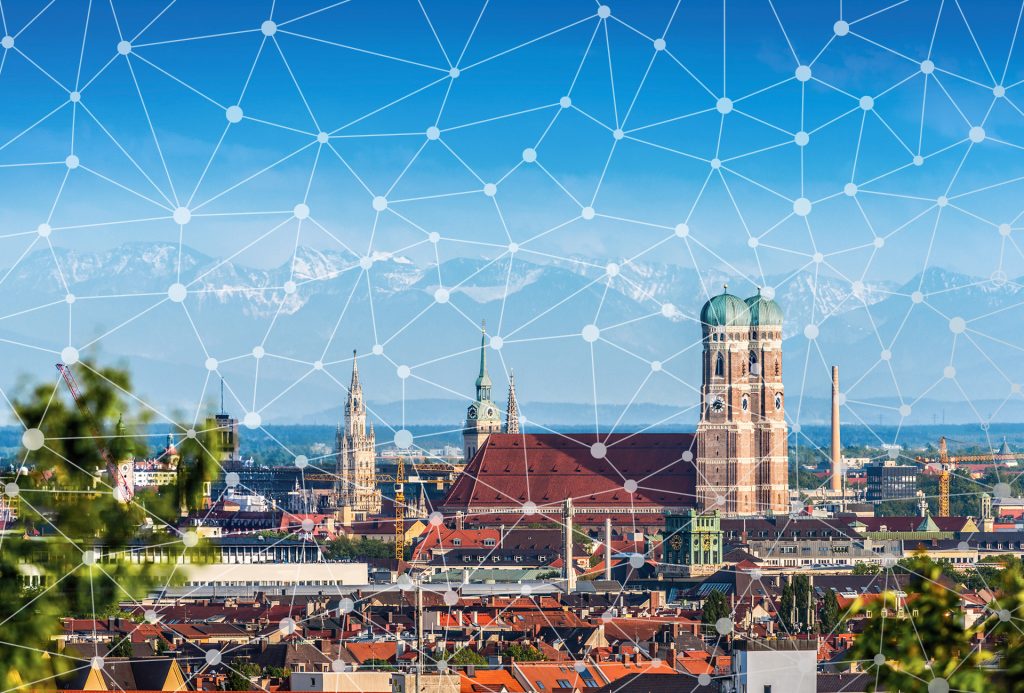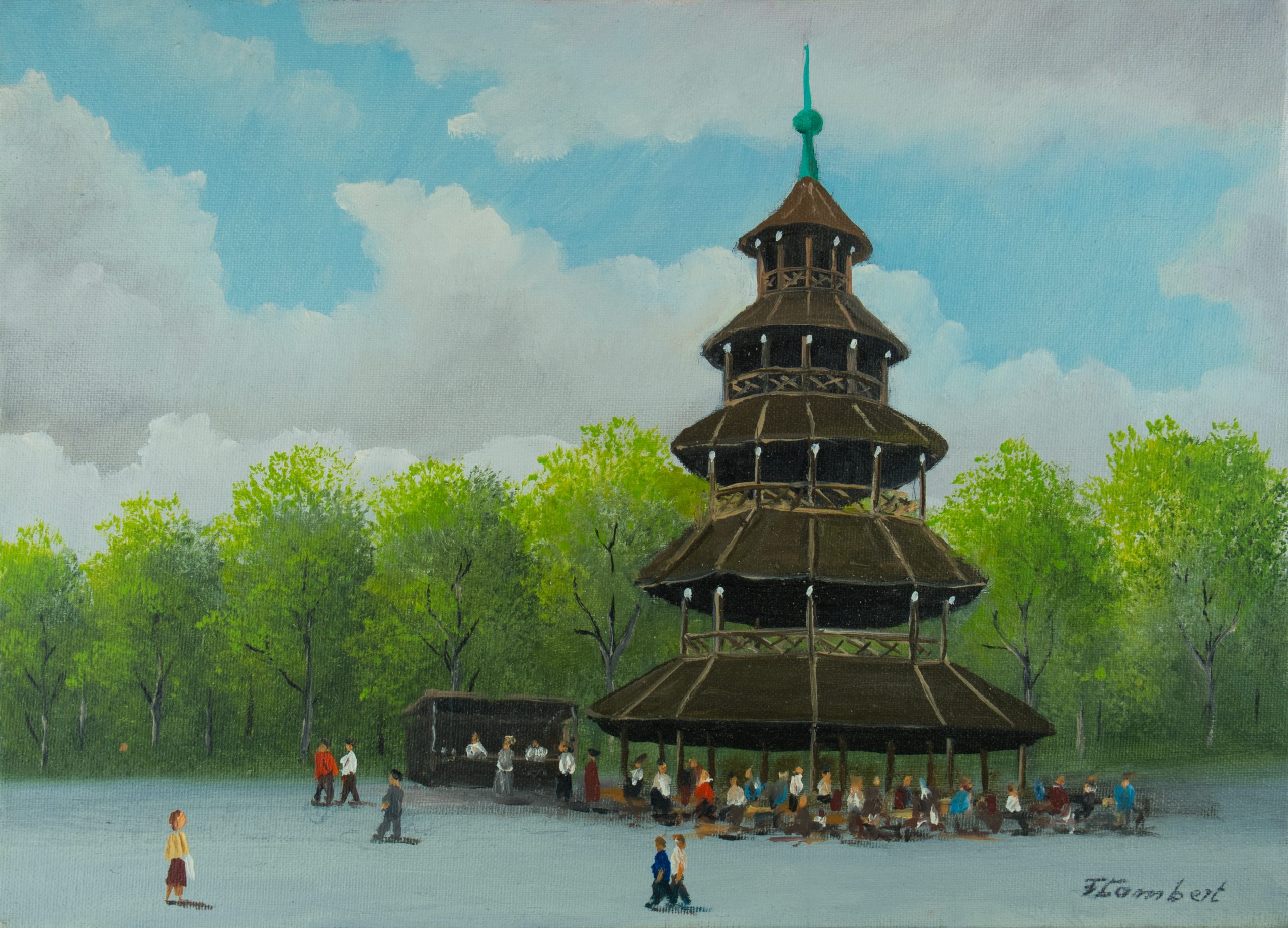In
Blog 2023
christian steinau
Making globalisation processes visible on the ground

Image courtesy of Adobe stock, adapted by the author.
Globalisation affects our world in diverse and complex ways. Based on the work at gd:c, the transfer project
Global Munich shows how dis:connective globalisation processes shape the city of Munich, ranging from historical examples to astonishing contemporary references. From economic and cultural connections to more or less visible borders, Munich is linked to the world in many ways. But how do these links become manifest in the city itself? What makes Munich a global city?
The gd:c TransferLab is the brains and motor behind Global Munich.
[1] The mission of the TransferLab is to develop applications for our output and to draw on current developments in the field of transfer. Transfer refers to the ‘dialogical communication and transfer of scientific findings to society, culture, the economy and politics’ and vice versa.
[2]
Global Munich applies the concept of dis:connective globalisation to the city of Munich and relates it to concrete examples in the most local of contexts. It will create public documentation and provide opportunities for gd:c staff and fellows to get involved in the process. And Global Munich will engage stakeholders outside the university.
Munich as a global city? A first (dis:)connective look at the city
Due to its diverse connections to the world, Munich is a vivid example of how globalisation processes form a dense network. The city is a transport hub in the air and on land. People and goods move in all directions, as do data. This connectivity is the heart of Munich's globally connected economy. Munich is home to some of Germany's largest companies, and many international corporations do business here.
Munich is a locus for culture and the arts, home to globally active and connected publishing houses, advertising agencies, film producers, art collections and museums. Tourism is a key economic factor, and the city receives millions of guests annually. Munich is also a magnet for international emigrants who contribute to a lively cultural exchange. Globalisation processes pervade the city and leave their visible and less visible traces all over the cityscape and in the lifeworlds of both visitors and inhabitants of Munich.

The Chinese Tower in the English Garden (Image: Adobe Stock)
Many of these links and connections have a long history and reach back to imperial times or even further. Think of the Orientalism mirrored in the Chinese Tower in the English Garden, the role of the Bavarian ‘Chinese warriors’ from the Max II barracks in quelling the Boxer Rebellion and the global branding success of the ‘world's largest folk festival’, the Oktoberfest. Small wonder that the first impulse to document and make visible the various manifestations of these links originally came from the field of history. Global Munich takes its cue from this historical approach and extends it into the contemporary realm.
The concept of transfer in Global Munich
A particular concept of transfer underlies the content and methods of the TransferLab. Every transfer project must confront the question of what transfer means. What is to be ‘transferred’, how and why? What is the added value of the concept?
There is no single definition of transfer. A range of transfer activities can perform the underlying transfer (Latin
trānsferre = ‘to carry from one place to another’) of findings and knowledge, for instance in fields such as relationship management, entrepreneurship, scientific consulting, science dialogue and research and development with society.
[3] Alongside the existence of the necessary institutional prerequisites, the quality of transfer depends on ‘more or less comprehensive, forward-looking, longer-term and interactive or dialogical processes’.
[4] Accordingly, ‘a simple linear model of transfer in the sense of transferring already acquired explicit and documented knowledge to other areas of society is unrealistic in most cases and falls short’.
[5]
The TransferLab at gd:c is guided by the purpose of developing persuasive and innovative transfer, and Global Munich is one of its best examples. The historical data and sources on global places in Munich that our colleagues at the history department have gathered provide the raw material for a long-term transfer process that does not presuppose an epistemic conclusion, but expands and creates new knowledge on the basis of dialogue. The process pursues five principal goals:
- rooting the concept of dis:connective globalisation in the documentation of concrete local examples
- illuminating Munich’s municipal history and present from a new globally dis:connected perspective
- involving gd:c staff and fellows in a transfer project right at their doorstep
- systematically planning and implementing transfer activities, ranging from (dialogue-oriented) research communication to participatory processes involving non-academic stakeholders
- making the concept of dis:connectivity accessible to target groups outside the university

(Photo: Adobe Stock, adapted by the author)
Modules of Global Munich
Global Munich operates across these diverse transfer contexts with three modules, each of which relates to both content and methodology:
- opening the historical perspective to (interdisciplinary) contemporary references
- involving gd:c staff and fellows
- involving stakeholders outside the university
Opening the historical perspective to (interdisciplinary) contemporary references
Global Munich is developing a collection of global historical sites in Munich. One component is expanding the range of sources to contemporary references and other, less historical perspectives. A transfer perspective recommends this because communication is successful precisely when it is relevant and current. So, where is dis:connection currently materialising in Munich?
Integrating contemporary sources aims to highlight both the ubiquity as well as the complexity of globalisation processes and to infer new connections that define Munich as a global city. The project maintains the historical view of a rich urban history while seeking points of connection in the present. To extend the historical material, this historical knowledge is linked to new contexts from other disciplines and non-academic sources.
Involving staff and fellows
The core of global dis:connect are the research fellows. They enrich our academic exchange and add new perspectives to the discussion on dis:connectivity. Beyond broadening the question of where dis:connectivity appears historically and presently in Munich, Global Munich provides staff and fellows the opportunity to apply their art and research to the city of Munich. It offers a framework for exchanging ideas on our underlying research question through the location of Munich. Unlike colloquia or conferences, however, this exchange does not heed academic rules. There is no right or wrong, no obligation to participate in anything and no pressure to publish. The focus is on the curiosity about what constitutes dis:connectivity and where it appears in Munich.
In addition to the TransferLab’s own research, the output of fellows and staff can feed into conclusive results. In this respect, Global Munich is based on cooperation and exchange that combines different bodies of knowledge in conversation about the city. This can include roundtables, walks, coffee talks and similar formats. The project is a space for dynamic, spontaneous exchange between fellows and staff.
Transfer presupposes an open-ended exchange. Global Munich nudges staff and fellows to apply their knowledge in a new context, eliciting unusual insights and exciting discussions. Participation is voluntary, aiming to go beyond our research.
Involving stakeholders outside the university
The third module follows from the assumption that a project called
Global Munich cannot be thought of solely from an academic point of view. Our circumstances are privileged. Public funding makes us independent of short-term economic vacillations. Without neglecting research, transfer adds a dimension of academic work. By reaching out beyond to diverse actors in Munich's urban society, new perspectives and sources for research emerge. Likewise, the diversity of urban society becomes methodologically visible.
The focus is an open-ended exchange, without commitment to a final result, preferring a multi-layered image of Munich developed by project partners, stakeholders and communities. Global Munich is designed to be open-ended and to adapt through non-linear dialogue.
Transfer aims to develop and explore of research perspectives with partners outside the university. The project attempts to go beyond typical academic work, to reflect on them and to complement them with practical, problem-solving research. By looking ‘outside’, scientific work changes. Global Munich proves that transfer can meaningfully complement research in the humanities and social sciences.
Formats of public documentation
This text could only provide a rough sketch of the possibilities for locating globalisation processes in Munich. Global Munich aims to explore where globalisation takes place in urban space as concretely and practically as possible and to make it accessible with texts, images and sources. Such documentation will form the conclusion of the project and will be compiled until spring 2025 as a test of global dis:connect’s hypotheses about dis:connectivity with reference to real-world examples.
Various opportunities for communication emerge in the course of revising and expanding the non-academic source material on global places in Munich
. Global Munich will continue to integrate narratives from our neighbours and cooperation partners.
[1] For more on the Transfer Lab, consult our webpage:
https://www.globaldisconnect.org/transferlab/.
[2] Wissenschaftsrat,
Perspektiven des deutschen Wissenschaftssystems (Cologne, Bielefeld, 2013), 2, https://www.wissenschaftsrat.de/download/archiv/3228-13.html. Unless otherwise indicated, all translations are by the author.
[3] Andrea Frank et al.,
Transferbarometer: Executive Summary, Stifterverband für die Deutsche Wissenschaft (Essen, 2022), https://www.stifterverband.org/transferbarometer/executive-summary.
[4] Wissenschaftsrat,
Wissens- und Technologietransfer als Gegenstand institutioneller Strategien (Weimar, 2016), 11, https://www.wissenschaftsrat.de/download/archiv/5665-16.html.
[5] Wissenschaftsrat,
Wissens- und Technologietransfer.
Bibliography
Frank, Andrea, Cornels Lehmann-Brauns, Frauke Lohr, Arne Meyer-Haake, and Daniel Riesenberg.
Transferbarometer: Executive Summary. Stifterverband für die Deutsche Wissenschaft (Essen: 2022). https://www.stifterverband.org/transferbarometer/executive-summary.
Wissenschaftsrat.
Perspektiven Des Deutschen Wissenschaftssystems. (Cologne, Bielefeld: 2013). https://www.wissenschaftsrat.de/download/archiv/3228-13.html.
———.
Wissens- Und Technologietransfer Als Gegenstand Institutioneller Strategien. (Weimar: 2016). https://www.wissenschaftsrat.de/download/archiv/5665-16.html.
citation information:
Steinau, Christian, 'Global Munich - a transfer project by global dis:connect', Ben Kamis ed. gd:c blog. Käte Hamburger Research Centre global dis:connect, 2 October, 2023, https://www.globaldisconnect.org/10/02/global-munich-a-transfer-project-by-global-disconnect/.
Continue Reading
 In early October, Matthias Leanza joins global dis:connect as a new fellow. Welcome to Munich, Matthias!
Matthias Leanza is a historical sociologist specialising in empires, colonialism and nation-state formation and is a senior lecturer at the University of Basel.
At global dis:connect Matthias will complete his current book project on the legacy of German colonialism. Drawing on a wide range of sources from European and African archives, the study shows how and why the German overseas empire helped consolidate the nascent German nation-state. Germany soon lost its colonies, but their effects on the country persisted, leaving a complex legacy. Continue Reading
In early October, Matthias Leanza joins global dis:connect as a new fellow. Welcome to Munich, Matthias!
Matthias Leanza is a historical sociologist specialising in empires, colonialism and nation-state formation and is a senior lecturer at the University of Basel.
At global dis:connect Matthias will complete his current book project on the legacy of German colonialism. Drawing on a wide range of sources from European and African archives, the study shows how and why the German overseas empire helped consolidate the nascent German nation-state. Germany soon lost its colonies, but their effects on the country persisted, leaving a complex legacy. Continue Reading






 In October Valeska Huber commenced her term as a fellow at global dis:connect. Welcome.
Valeska Huber is a professor at the University of Vienna. She has led an Emmy Noether Research Group and has been a fellow at the German Historical Institute London. She is particularly interested in the mutual interdependence of opening and closure.
During her fellowship at global dis:connect, she will work on a monograph about the 20th-century dream of universal literacy, tracing the Each One Teach One method propagated by US missionary Frank C. Laubach and applied around the globe from the Philippines to Cuba and Brazil.
In October Valeska Huber commenced her term as a fellow at global dis:connect. Welcome.
Valeska Huber is a professor at the University of Vienna. She has led an Emmy Noether Research Group and has been a fellow at the German Historical Institute London. She is particularly interested in the mutual interdependence of opening and closure.
During her fellowship at global dis:connect, she will work on a monograph about the 20th-century dream of universal literacy, tracing the Each One Teach One method propagated by US missionary Frank C. Laubach and applied around the globe from the Philippines to Cuba and Brazil.  A warm welcome to our new guest Joël Glasman who joins global dis:connect in october.
A warm welcome to our new guest Joël Glasman who joins global dis:connect in october.


 In September David Motadel commenced his term as a fellow at global dis:connect. Welcome.
David Motadel is an associate professor of international history at the LSE. A former Gates Scholar at Cambridge, he has held visiting positions at Harvard, Yale, Oxford, Sciences Po and the Sorbonne.
At gd:c he is working on a global history of Europe’s empires around the Second World War, 1935-1948, exploring the history of the war in the imperial world, its impact on colonial subjects; the history of the colonial soldiers who fought in Europe’s armies; the history of anti-colonial movements during the war, from the Viet Minh to the Quit India movement; and the war’s impact on the end of empire and twentieth-century world order.
In September David Motadel commenced his term as a fellow at global dis:connect. Welcome.
David Motadel is an associate professor of international history at the LSE. A former Gates Scholar at Cambridge, he has held visiting positions at Harvard, Yale, Oxford, Sciences Po and the Sorbonne.
At gd:c he is working on a global history of Europe’s empires around the Second World War, 1935-1948, exploring the history of the war in the imperial world, its impact on colonial subjects; the history of the colonial soldiers who fought in Europe’s armies; the history of anti-colonial movements during the war, from the Viet Minh to the Quit India movement; and the war’s impact on the end of empire and twentieth-century world order.  A warm welcome to our new fellow Günther Sandner who joins global dis:connect in early September.
Günther Sandner is a political scientist and historian. He works as a research fellow at the Institute Vienna Circle (University of Vienna) and teaches civic education extramurally. His research includes the history of logical empiricism and Isotype.
His project at gd:c, Following Isotype: visual languages and universal symbols in the decades after 1945, deals with projects that aimed to overcome the active absence of a universal language and to establish one with the help of pictures, graphics, symbols and pictograms. Its focus is on the 1950s and 1960s.
A warm welcome to our new fellow Günther Sandner who joins global dis:connect in early September.
Günther Sandner is a political scientist and historian. He works as a research fellow at the Institute Vienna Circle (University of Vienna) and teaches civic education extramurally. His research includes the history of logical empiricism and Isotype.
His project at gd:c, Following Isotype: visual languages and universal symbols in the decades after 1945, deals with projects that aimed to overcome the active absence of a universal language and to establish one with the help of pictures, graphics, symbols and pictograms. Its focus is on the 1950s and 1960s.  In early September, Ayala Levin joins global dis:connect as a new fellow. Welcome to Munich, Ayala!
Ayala Levin is an associate professor of architectural history at the University of California, Los Angeles. Ayala specialises in architecture and urban planning in postcolonial African states with interest in the production of architectural knowledge as part of north-south or south-south exchange.
At global dis:connect Ayala will research how U.S. planners sought to reorganise rural spaces in post-independence African states to curb urban migration.
In early September, Ayala Levin joins global dis:connect as a new fellow. Welcome to Munich, Ayala!
Ayala Levin is an associate professor of architectural history at the University of California, Los Angeles. Ayala specialises in architecture and urban planning in postcolonial African states with interest in the production of architectural knowledge as part of north-south or south-south exchange.
At global dis:connect Ayala will research how U.S. planners sought to reorganise rural spaces in post-independence African states to curb urban migration.  Judd C. Kinzley from the University of Wisconsin-Madison joined global dis:connect in early July.
Judd Kinzley is a professor of modern Chinese history. His research treats borderlands, materiality and natural resources. He is currently working on the transnational exchange of Chinese raw materials for cash, weapons and industrial goods during World War II. This work reveals the transnational networks that developed to finance, produce and transport such resources. These trans-Pacific networks channelled objects in both directions during the war and served as the blueprint of a new postwar international order.
His project at gd:c focuses on the legacies of Allied wartime oil exports to China , the Middle East, SE Asia, the US and the European powers together.
Judd C. Kinzley from the University of Wisconsin-Madison joined global dis:connect in early July.
Judd Kinzley is a professor of modern Chinese history. His research treats borderlands, materiality and natural resources. He is currently working on the transnational exchange of Chinese raw materials for cash, weapons and industrial goods during World War II. This work reveals the transnational networks that developed to finance, produce and transport such resources. These trans-Pacific networks channelled objects in both directions during the war and served as the blueprint of a new postwar international order.
His project at gd:c focuses on the legacies of Allied wartime oil exports to China , the Middle East, SE Asia, the US and the European powers together.
 A warm welcome to our new guest Michael Goebel who joins global dis:connect in early September.
A warm welcome to our new guest Michael Goebel who joins global dis:connect in early September. In September Ifeoluwa Aboluwade commenced her term as a fellow at global dis:connect. Welcome.
Ifeoluwa Aboluwade is a literary scholar with a background in imperial and literary history, early modern English theatre, critical digital humanities, (trans)cultural translation and adaptation, black diaspora studies, postcolonial literary criticism, and gender and intersectionality. She works at the Africa Multiple Cluster of Excellence and is a lecturer at the University of Bayreuth. Ifeoluwa has received many international awards and fellowships, such as Fulbright and DAAD scholarships, most recently receiving the Shakespeare Association of America-Folger Shakespeare Library Short Term Fellowship (2022/2023).
At gd:c she is investigating the histories, patterns and genealogies (dis)connecting Shakespearean drama through topoi of trickster and warrior.
In September Ifeoluwa Aboluwade commenced her term as a fellow at global dis:connect. Welcome.
Ifeoluwa Aboluwade is a literary scholar with a background in imperial and literary history, early modern English theatre, critical digital humanities, (trans)cultural translation and adaptation, black diaspora studies, postcolonial literary criticism, and gender and intersectionality. She works at the Africa Multiple Cluster of Excellence and is a lecturer at the University of Bayreuth. Ifeoluwa has received many international awards and fellowships, such as Fulbright and DAAD scholarships, most recently receiving the Shakespeare Association of America-Folger Shakespeare Library Short Term Fellowship (2022/2023).
At gd:c she is investigating the histories, patterns and genealogies (dis)connecting Shakespearean drama through topoi of trickster and warrior.